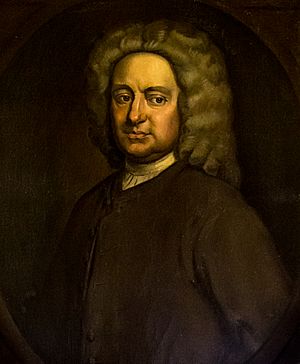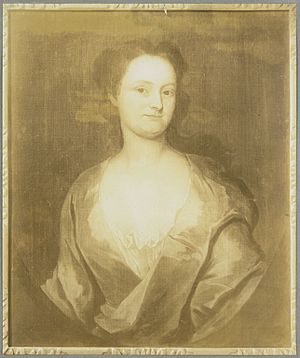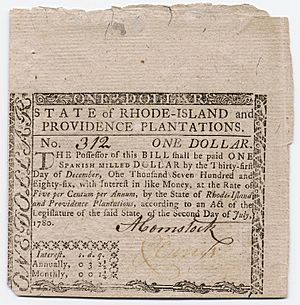William Greene (colonial governor) facts for kids
Quick facts for kids
William Greene Sr.
|
|
|---|---|
 |
|
| 23rd, 25th, 27th, and 29th Governor of the Colony of Rhode Island and Providence Plantations | |
| In office 1743–1745 |
|
| Preceded by | Richard Ward |
| Succeeded by | Gideon Wanton |
| In office 1746–1747 |
|
| Preceded by | Gideon Wanton |
| Succeeded by | Gideon Wanton |
| In office 1748–1755 |
|
| Preceded by | Gideon Wanton |
| Succeeded by | Stephen Hopkins |
| In office 1757–1758 |
|
| Preceded by | Stephen Hopkins |
| Succeeded by | Stephen Hopkins |
| 26th Deputy Governor of the Colony of Rhode Island and Providence Plantations | |
| In office 1740–1743 |
|
| Governor | Richard Ward |
| Preceded by | Richard Ward |
| Succeeded by | Joseph Whipple Jr. |
| Personal details | |
| Born | 16 March 1695 Warwick, Rhode Island |
| Died | 23 January 1758 (aged 62) Providence, Rhode Island |
| Resting place | Governor Greene Cemetery, Love Lane, Warwick |
| Spouse | Catharine Greene |
| Occupation | Clerk of Providence County Court, Speaker of Rhode Island Assembly, Deputy Governor, Governor |
William Greene Sr. (born March 16, 1695 – died January 23, 1758) was an important leader in the early American colony of Rhode Island. He served as the governor of the colony four different times, for a total of 11 years. Before becoming governor, he held several other important jobs. He was a court clerk in Providence, a representative (called a deputy) from Warwick, and the speaker of the Rhode Island Assembly. He also served as the deputy governor from 1740 to 1743. William Greene Sr. passed away while still serving as governor during his last term.
Contents
Early Political Life
William Greene became a "freeman" of the colony in 1718. This meant he had the right to vote and hold public office. When he was 32, in 1727, he was chosen to be a deputy from Warwick. He held this job for five years.
He also worked as a clerk for the county court in Providence. In 1734 and 1739, he was the speaker of the Rhode Island Assembly. This was a very important role, like being the leader of the colony's law-making group. In 1728, he helped survey the border between Rhode Island and Connecticut.
Becoming Deputy Governor
When Governor John Wanton died in 1740, Richard Ward became the new governor. William Greene then became the Deputy Governor. He served in this role until May 1743. That's when he was elected governor himself. It was unusual for a Rhode Island governor to come from outside Aquidneck Island, where the main towns of Newport and Portsmouth were located.
Governor of Rhode Island
William Greene served as governor for four separate terms. His first term began in 1743. During his time in office, he faced many important issues.
Colony Borders and New Towns
One major topic during Greene's first term was the colony's borders. Several geographic lines were changed. New towns like Barrington, Warren, and Bristol became part of Bristol County. Also, Tiverton and Little Compton were added to Newport County, joining the towns on Aquidneck Island.
War and Defense Efforts
Another big challenge for the colony was the war against France and Spain. England expected its colonies to help defend the Crown. When England declared war on France in March 1744, Rhode Island prepared for battle. The colony strengthened its forts with guns and ammunition.
Rhode Island forces also helped in a big battle far away. Commodore Warren, with help from Rhode Island soldiers, attacked Louisbourg in Nova Scotia. This strong fort surrendered in June. People in Europe were surprised that the "strongest fortress of North America had given up to American farmers, mechanics, and fishermen." Rhode Island also had several small warships and 15 privateer ships. These privateers were successful in capturing 20 enemy ships and bringing them to Newport.
Political Challenges and His Death
During Greene's third term as governor, the colony faced a lot of political disagreements. Two future governors, Samuel Ward and Stephen Hopkins, led two opposing groups. William Greene sided with the Ward group.
The disagreements were about several things:
- Whether the colony should be at war or peace.
- Whether to use paper money or "hard currency" (like coins).
- The interests of Providence versus the interests of Newport.
Elections often went back and forth between these two sides. Amidst all this political fighting, William Greene died while still in office on January 23, 1758. He was buried in the Governor Greene Cemetery in Warwick.
Family Life

William Greene married his second cousin, Catharine Greene. Her parents were Benjamin and Susanna (Holden) Greene. Catharine was also a granddaughter of Randall Holden and a great-granddaughter of the first John Greene Sr..
William and Catharine had six children together. Five of their children lived to be adults. Their son, William Greene Jr., later became the second governor of Rhode Island after it became a state.


